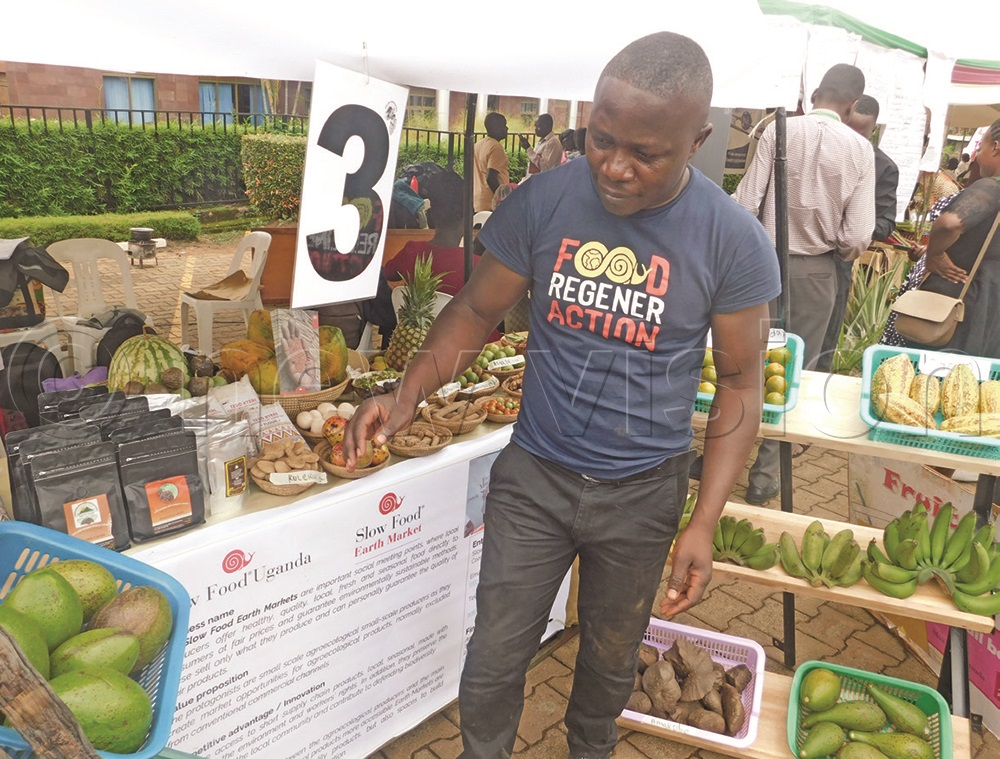By Joshua Kato
If you love indigenous foods, then the place to be last week was the expansive Hotel Africana parking yard.
From crops, such as yams, wild beans, organic cassava, millet and sorghum, sesame, potatoes, greens, nuts to local chicken, turkey and guinea fowls, the normally quiet parking yard at the city hotel was bustling with activity.
Under the big tent, tens of farmers from across the country gathered, not just to exhibit their organic produce, but also stop the extinction of some of the foods.
PELUM, in collaboration with the agriculture and trade ministries, organised the national agro-ecology week of action, which run from October 21 to October 26, at Hotel Africana.
The activities include three events all linked to agroecology practices.
“The three events provided platforms for participation of different actors within the agriculture and agro-ecology spaces,” Eddi Mukiibi, from Slow Foods International, explains.
According to Mukiibi, agro-ecology can resolve hunger sustainably, address problems and limitations of industrial agriculture, such as the increased poverty and malnutrition rate, inequality and environmental degradation, particularly climate change, that hinder hunger and poverty eradication.
Mukiibi says smallholder farmers, constituting the majority of players in both crop and livestock sectors, have been crucial in producing food and cash crops, noting that they employ a significant portion of the population, including youth, women and the elderly.
He adds that their efforts have contributed to Uganda’s food security within the East African community.

“And they are also working hard to preserve some of these indigenous food varieties,” Mukiibi says.
Josephine Luyimbazi, the country director of PELUM Uganda, believes that embracing agro-ecology is essential to guaranteeing food sovereignty, responsible investments and respecting the rights and needs of local citizens, especially for small-scale farmers.
She says by adopting comprehensive approaches, such as agro-ecology, Uganda’s farmers are positioning themselves as agents of community change, working towards a future where food is abundant, income is steady and poverty is reduced.
They play a vital role in supplying over 80% of the food in the sub-Saharan region, further solidifying their critical importance in the country’s agricultural landscape.
Luyimbazi says agro-ecology should be integrated in all levels of institutions starting with schools and involvement of youths who contribute the largest percentage of Uganda’s population.
“We call for certification of agro-ecology products which will inspire more farmers to get involved. Climate change is real and needs to be tackled through agro-ecology farming,” she added.
In addition, Luyimbazi called for better technologies to support the entire agro[1]ecology system, regulation of toxic chemicals, incentives to agro-ecology farmers, building accessible agro-ecology markets countrywide and beyond.
Exhibitors on show
Exhibitors came from as far as Soroti in the east to Mbarara in the west, all of them carrying along fresh, dried or even cooked indigenous foods.
Christopher Magala, a farmer who exhibited under Slow Food Organisation, says all that is needed is mindset change, because for now, Ugandans have been made to believe that one can only grow food with chemicals, which is wrong.
“We need to rebuild the systems. Like in Buganda, we had leadership from the house, throughout the clan lineage to the king. Today, they are not functional. We need to revamp the systems, which will take us back to healthy living,” he says.
Julius Bigabwa, the proprietor of Biglad Organic Training Centre in Kabarole district, was one of the exhibitors. Among the items that he exhibited was organically grown macadamia.
Bigabwa says as macadamia nuts gain popularity worldwide for their rich flavour and nutritional value, they present a profitable opportunity for farmers looking to tap into this market.
Adding value to macadamia is not just about increasing income; it’s about creating sustainable products, attracting diverse buyers and enhancing market resilience.
With the right knowledge and techniques, farmers can unlock significant economic benefits and establish a competitive edge.
Bigabwa explains that macadamia nuts begin with careful harvesting, adding that nuts should be harvested when they naturally fall from the tree, ensuring they are mature and packed with flavour.
The next step involves drying the nuts to reduce moisture content, which is vital for both quality and shelf-life. Proper drying techniques help preserve the nuts’ rich oils and prevent spoilage.
According to Bigabwa, farmers can invest in basic drying equipment or use natural sun-drying methods, which can be highly effective in regions with sufficient sunlight.
“Cracking the nuts carefully to preserve whole kernels, which are often more valuable, is another critical step. Precision in processing, from drying to cracking, sets a high standard and forms the foundation for any further value-added steps,” he says.
Maureen Nyakato from Fort Portal city, exhibited organically grown and processed vegetables and herbs. Her stall had rare dried vegetables like jobyo (bitter leaves) and gobe.
LEAD PHOTO CAPTION: Some of the indigenous food showcased included legumes.





